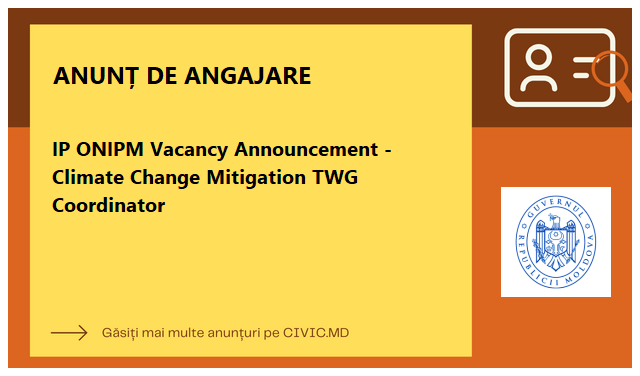Organizații vizate:
Anunțuri de Angajare
- Detalii
- Categorie: Angajări
IP ONIPM Vacancy Announcement - Climate Change Mitigation TWG Coordinator
Informațiile prezentate în articolul de mai jos pot să nu mai fie actuale sau să nu mai reflecte activitățile și programele curente. Anunțul este păstrat în arhivă pentru a asigura transparența și accesul public la informațiile despre inițiativele și proiectele implementate anterior.

|
PUBLIC INSTITUTION “ENVIRONMENTAL PROJECTS NATIONAL IMPLEMENTATION OFFICE”, PROJECT MANAGEMENT UNIT OF THE SECOND BIENNIAL TRANSPARENCY REPORT AND SIXTH NATIONAL COMMUNICATION UNDER THE UNFCCC VACANCY ANNOUNCEMENT |
||
|
I. Position Information |
||
|
Project title: |
“Moldova: Enabling Activities for the Preparation of Combined Second Biennial Transparency Report and Sixth National Communication (BTR2/NC6) to the United Nations Framework Convention on Climate Change (UNFCCC)”. |
|
|
Job title (part-time position):
|
Climate Change Mitigation and MRV Systems Thematic Working Group Coordinator |
|
|
Indicative workload:
|
Up to 10 working/days per month |
|
|
Duration of employment: |
June 2025 – September 2026, with possibility of extension until December 2026 |
|
|
II. Background |
||
|
The project aims to support the Republic of Moldova (RoM) to prepare and submit its Combined Second Biennial Transparency Report and Sixth National Communication (BTR2/NC6) that complies with the United Nations Framework Convention on Climate Change (UNFCCC) and Paris Agreement (PA) reporting requirements while responding to national development goals. Under the UNEP/GEF Project “Moldova: Enabling Activities for the Preparation of Combined Second Biennial Transparency Report and Sixth National Communication (BTR2/NC6) to the United Nations Framework Convention on Climate Change (UNFCCC)”, Moldova will receive support to prepare its BTR2/NC6 report and submit it to the UNFCCC by December 2026, in compliance with UNFCCC and PA reporting requirements and in alignment to national development goals, with built-in flexibility provided in light of its capacities. Moreover, the country will be supported to undertake a self-assessment and stocktaking exercise for preparation of the project proposal for the subsequent BTR development. Thus, the two expected outputs under the BTR2/NC6 project are as following: Output 1: BTR2/NC6 report prepared and submitted to UNFCCC by December 2026; Output 2: Self-assessment and stocktaking exercise for preparation of the project proposal for subsequent BTR3 under the UNFCCC and Paris Agreement completed. The content of deliverables produced under the first output must follow the Modalities, Procedures and Guidelines (MPGs) for the transparency framework for action and support referred to in Article 13 of the Paris Agreement (FCCC/PA/CMA/2018/3/Add.2). Moreover, as adopted at COP 26 in Decision 5/CMA.3, the following will be observed: (i) outlines for the BTR & National Inventory Document (NID); (ii) the Common Reporting Tables (CRT) for reporting GHG Inventory and the Common Tabular Formats (CTF) for reporting the NDC progress, financial, technology development and transfer and capacity-building support provided and mobilized, as well as support needed and received (FCCC/PA/CMA/2021/10/Add.2). The BTR2/NC6 project will build on findings and recommendations from the technical expert review of the BTR1 and expert review of previous NCs and BURs. The combined BTR2/NC6 Report is expected to include the following content: · National inventory report of anthropogenic emissions by sources and removals by sinks of greenhouse gases; · Information necessary to track progress made in implementing and achieving nationally determined contributions under Article 4 of the Paris Agreement; · Information related to climate change impacts and adaptation under Article 7 of the Paris Agreement; · Information on financial, technology development and transfer and capacity-building support needed and received under Articles 9–11 of the Paris Agreement; · Other relevant information, including: Research and Systematic Observation; Education, Training and Public Awareness; and Gender Mainstreaming into the Climate Policies; · Publication and submission of report, and other project execution support. |
||
|
III. Organizational Context |
||
|
The project is executed by the BTR2/NC6 Project Management Unit (PMU) established by the Public Institution “Environmental Projects National Implementation Office” (P.I. “EPNIO”) of the Ministry of Environment (MoEN), on behalf of the Government of the Republic of Moldova, and in consultation with the UNEP. As national executing agency, the PMU established by the P.I. “EPNIO” is primarily responsible for the planning and management of the project activities, accounting, reporting, monitoring and evaluation of the project. Under the guidance and direct supervision of the National Project Manager (NPM), the Climate Change Mitigation and MRV Systems Thematic Working Group Coordinator will lead the developing of: · Chapter 2: ‘Information necessary to track progress made in implementing and achieving nationally determined contributions under Article 4 of the Paris Agreement’, which aims to provide a description of the Republic of Moldova’s national circumstances and information on institutional arrangements relevant to implementing and achieving the NDC economy-wide emissions reduction targets, GHG emissions and removals projections and any other information relevant to tracking progress made in implementing and achieving its NDC. Information to be provided in this chapter includes but is not limited to: · National circumstances and institutional arrangements; · Description of the Republic of Moldova’s nationally determined contribution under Article 4 of the Paris Agreement, including updates; · Information necessary to track progress made in implementing and achieving its nationally determined contribution under Article 4 of the Paris Agreement, reported in a narrative and common tabular format, as applicable; · Mitigation policies and measures, actions and plans, including those with mitigation co-benefits resulting from adaptation actions and economic diversification plans, related to implementing and achieving a nationally determined contribution under Article 4 of the Paris Agreement; · Summary of greenhouse gas emissions and removals, concerning the reporting years corresponding to the Party’s most recent National Inventory Report, in a tabular format; · Projections of greenhouse gas emissions and removals, as applicable, presented in graphical and tabular formats; · Other information relevant to tracking progress made in implementing and achieving its NDC under Article 4 of the Paris Agreement; · Specific flexibility provisions applied; · Information on areas of improvement in relation to reporting over time. The above proposed scope of work is categorized into the following five main deliverables: 1.2.1. The section on the Republic of Moldova’s national circumstances and institutional arrangements in place to track progress made in implementing and achieving its NDC under Article 4 of the Paris Agreement compiled: - Describe the national circumstances relevant to progress made in implementing and achieving its NDC under Article 4 of the Paris Agreement, including: (a) Government structure: roles and responsibilities of different levels of government and relevant interministerial decision-making processes or bodies; (b) Population profile: total population, density and distribution; (c) Geographical profile: area, latitude, land use and ecosystem; (d) Climate profile: temperature distribution, annual temperature variation, precipitation distribution, climate variability and extreme events; (e) Economic profile: gross domestic product (GDP), GDP per capita (expressed in domestic currency and purchasing power parity), GDP by sector and international trade patterns; and (f) Sector details: (i) Energy (by fuel type, where appropriate): energy resource base, production, market structure, prices, taxes, subsidies and trade; (ii) Transportation: modes (passenger and freight), travel distances and fleet characteristics; (iii) Building stock and urban structure: profile of residential and commercial buildings; (iv) Industry: structure; (v) Agriculture: structure and management practices; (vi) Forest: types and management practices; (vii) Waste: waste sources and management practices. - Provide information on the institutional arrangements in place to track progress made in implementing and achieving its NDC under Article 4 of the Paris Agreement, including those used for tracking internationally transferred mitigation outcomes, if applicable, along with any changes in institutional arrangements since its most recent biennial transparency report; - Provide information on legal, institutional, administrative and procedural arrangements for domestic implementation, monitoring, reporting, archiving of information and stakeholder engagement related to the implementation and achievement of its NDC under Article 4 of the Paris Agreement. 1.2.2. The section providing a description of the Republic of Moldova’s NDC under Article 4 of the Paris Agreements, including updates compiled: - Describe the current NDC under Article 4 of the Paris Agreement, against which progress will be tracked, including any updates to information previously provided: (a) Target(s) and description, including target type; (b) Target year(s) or period(s), and whether they are single-year or multi-year target(s); (c) Reference point(s), level(s), baseline(s), base year(s) or starting point(s), and their respective value(s); (d) Time frame(s) and/or periods for implementation; (e) Scope and coverage, including, as relevant, sectors, categories, activities, sources and sinks, pools and gases; (f) Intention to use cooperative approaches that involve the use of internationally transferred mitigation outcomes under Article 6 towards NDCs under Article 4 of the Paris Agreement; (g) Any updates or clarifications of previously reported information (e.g. recalculation of previously reported inventory data, or greater detail on methodologies or use of cooperative approaches). - Provide information necessary to track progress made in implementing and achieving the current NDC, including information on the the qualitative or quantitative indicators selected to track progress towards the implementation and achievement of the updated NDC under Article 4 of the Paris Agreement, including, as relevant: net GHG emissions and removals, percentage reduction of GHG intensity, relevant qualitative indicators for a specific policy or measure, mitigation co-benefits of adaptation actions (e.g., hectares of reforestation, percentage of renewable energy use or production, share of non-fossil fuel in primary energy consumption and non-GHG related indicators). - Technical capacity building, including participation of project staff and national consultants in regional/international workshops and trainings on national determined contributions, mitigation policies and measures and their effects and projections, as appropriate. 1.2.3. The section on the mitigation policies and measures, actions and plans, including those related to implementing and achieving a nationally determined contribution under Article 4 of the Paris Agreement compiled: - Provide information on mitigation policies and measures, actions, and plans, including those with mitigation co-benefits resulting from adaptation actions and economic diversification plans, related to implementing and achieving the NDC. - Provide information on its actions, policies and measures, by sector (energy, transport, industrial processes and product use, agriculture, LULUCF, and waste management), to the extent possible, in a tabular format, including: name; description; objectives; type of instrument (regulatory, economic instrument or other); status (planned, adopted or implemented); sector(s) affected (energy, transport, industrial processes and product use, agriculture, lulucf, waste management or other); gases affected; start year of implementation; implementing entity or entities; costs; non-ghg mitigation benefits; how the mitigation actions interact with each other, as appropriate; - Provide, to the extent possible, estimates of expected and achieved GHG emission reductions for its actions, policies and measures in the tabular format; - Describe the methodologies and assumptions used to estimate the GHG emission reductions or removals due to each action, policy and measure, to the extent available; - Identify those actions, policies and measures that are no longer in place compared with the most recent BTR, and explain why they are no longer in place; - Identify its actions, policies and measures that influence GHG emissions from international transport; - Provide information about how its actions, policies and measures are modifying longer-term trends in GHG emissions and removals; - Provide information, to the extent possible, on the assessment of economic and social impacts of response measures. 1.2.4. The section providing the information on projections of GHG emissions and removals (time coverage, structure, NDC indicators, methodologies) compiled: - Describe the methodologies used to develop the projections, including information on: models and/or approaches used and key underlying assumptions and parameters used for projections (e.g. gross domestic product growth rate/level, population growth rate/level); changes in the methodology since the Party’s most recent BTR; assumptions on policies and measures included in the ‘with existing measures’ and in ‘with additional measures’ projections; sensitivity analysis for any of the projections, together with a a brief explanation of the methodologies and parameters used; - Provide the ‘with existing measures’ and ‘with additional measure’ projections (in graphical and tabular formats), including projections on the sectoral basis and by gas, as well as for the national total (provided with and without contribution of LULUCF sector), using a common metric consistent with that in the national inventory report, presented relative to actual inventory data for the preceding years; - Provide projections of key indicators to determine progress towards its NDC under Article 4 of the Paris Agreement. 1.2.5. Chapter 2: ‘Information necessary to track progress made in implementing and achieving nationally determined contributions under Article 4 of the Paris Agreement’ and common tabular formats for the electronic reporting of the information necessary to track progress in implementing and achieving nationally determined contributions under Article 4 of the Paris Agreement compiled: - Compile Chapter 2: ‘Information necessary to track progress made in implementing and achieving nationally determined contributions under Article 4 of the Paris Agreement’; - Compile the CTF tables in English with information necessary to track progress in implementing and achieving nationally determined contributions under Article 4 of the Paris Agreement; - Organize a national workshop to present the obtained results on the information necessary to track progress made in implementing and achieving the NDC under Article 4 of the Paris Agreement, to all interested partners and relevant stakeholders, policy makers, decision makers and with participation of the representatives of civil society and environmental NGOs. · Chapter 4 ‘Information on financial, technology development and transfer and capacity-building support needed and received under Articles 9–11 of the Paris Agreement’, which aims to provide information on national circumstances, institutional arrangements relevant to reporting on support needed and received, as well as a description of the underlying assumptions, methodologies and definitions, as applicable and information on financial support, technology development and transfer, and capacity-building support needed and received including for the implementation of Article 13 and transparency-related activities. Information to be provided in Chapter 4 includes but is not limited to:
The above proposed scope of work is categorized into the following eight deliverables: 1.4.1. The section on national circumstances, institutional arrangements and country-driven strategies relevant to reporting on provision and mobilization of support compiled, including: - A description of the systems and processes used to identify, track and report support needed and received, including a description of the challenges and limitations; - Information on country priorities and strategies and on any aspects of the Party s NDC under Article 4 of the Paris Agreement that need support. 1.4.2. The section on underlying assumptions, definitions and methodologies used to provide information on support needed and received compiled, including: - Describe the underlying assumptions, definitions and methodologies used to provide information on support needed and received, including, as applicable, those used to: convert domestic currency into United States dollars; estimate the amount of support needed; determine the reporting year or time frame; identify support as coming from specific sources; determine support as committed, received or needed; identify and report the status of the supported activity (planned, ongoing or completed); identify and report the channel (bilateral, regional or multilateral); identify and report the type of support (mitigation, adaptation or cross-cutting); identify and report the financial instrument (grant, concessional loan, non-concessional loan, equity, guarantee or other); identify and report sectors and subsectors; report on the use, impact and estimated results of the support needed and received; identify and report support as contributing to technology development and transfer and capacity-building; avoid double counting in reporting information on support needed and received for the implementation of Article 13 of the Paris Agreement and transparency related activities, including for transparency-related capacity-building, when reporting such information separately from other information on support needed and received. 1.4.3. Section on financial support needed and received compiled, including: - Provide information on financial support needed and received, including to the extent possible and as available and as applicable: (a) sectors for which the Party wishes to attract international finance, including existing barriers to attracting international finance; (b) description of how the support will contribute to its NDC and to the long-term goals of the Paris Agreement. - Provide, in a common tabular format, information on financial support needed, including the following, to the extent possible, and as available and as applicable: (a) title (of activity, programme or project); (b) programme/project description; (c) estimated amount (in domestic currency and in United States dollars); (d) expected time frame; (e) expected financial instrument (grant, concessional loan, non-concessional loan, equity, guarantee or other); (f) type of support (mitigation, adaptation or cross-cutting); (g) sector and subsector; (h) whether the activity will contribute to technology development and transfer and/or capacity-building, if relevant; (i) whether the activity is anchored in a national strategy and/or an NDC; (j) expected use, impact and estimated results. - Provide, in a common tabular format, information on financial support received, including, to the extent possible, and as available and as applicable: (a) title (of activity, programme or project); (b) programme/project description; (c) channel; (d) recipient entity; (e) implementing entity; (f) amount received (in domestic currency and in United States dollars); (g) time frame; (h) financial instrument (grant, concessional loan, non-concessional loan, equity, guarantee or other); (i) status (committed or received); (j) sector and subsector; (k) type of support (mitigation, adaptation or cross-cutting); (l) whether the activity has contributed to technology development and transfer and/or capacity-building; (m) status of activity (planned, ongoing or completed); (n) use, impact and estimated results. 1.4.4. Section on technology development and transfer needed and received compiled, including: - Provide, in textual format, information on technology development and transfer support needed under Article 10 of the Paris Agreement, including on, to the extent possible, and as available and as applicable: (a) plans, needs and priorities related to technology development and transfer, including those identified in technology needs assessments, where applicable; (b) technology development and transfer related needs for the enhancement of endogenous capacities and technologies; - Provide, in a common tabular format, information on technology development and transfer support needed, including, to the extent possible and as available and as applicable: (a) title (of activity, programme or project); (b) programme/project description; (c) type of support (mitigation, adaptation or cross-cutting); (d) type of technology; (e) expected time frame; (f) sector; (g) expected use, impact and estimated results; - Provide, in textual format, information on technology development and transfer support received under Article 10 of the Paris Agreement, including on, to the extent possible, and as available and as applicable: (a) case studies, including key success and failure stories; (b) how the support contributes to technology development and transfer, endogenous capacities and know-how; (c) the stage of the technology cycle supported, including research and development, demonstration, deployment, diffusion and transfer of technology; - Provide, in a common tabular format, information on technology development and transfer support received, including on, to the extent possible, and as available and as applicable: (a) title (of activity, programme or project); (b) programme/project description; (c) type of technology; (d) time frame; (e) recipient entity; (f) implementing entity; (g) type of support (mitigation, adaptation or cross-cutting); (h) sector; (i) status of activity (planned, ongoing or completed); (j) use, impact and estimated results. 1.4.5. Section on capacity-building support needed and received compiled, including: - Provide, in textual format, information on capacity-building support needed under Article 11 of the Paris Agreement, including on, to the extent possible and as available and as applicable: (a) the approach a Party seeks to take to enhance capacity-building support; (b) country-specific capacity-building needs, constraints and gaps in communicating those needs, and an explanation of how the capacity-building support needed would improve the provision of such information; (c) processes for enhancing public awareness, public participation and access to information in relation to capacity-building; - Provide, in a common tabular format, information on capacity-building support needed, including the following, to the extent possible, and as available and as applicable: (a) title (of activity, programme or project); (b) programme/project description; (c) expected time frame; (d) type of support (mitigation, adaptation or cross-cutting); (e) expected use, impact and estimated results. - Provide, in textual format, information on capacity-building support received under Article 11 of the Paris Agreement, including on, to the extent possible, and as available and as applicable: (a) case studies, including key success and failure stories; (b) how support received (c) capacity-building support received at the national and, where appropriate, subregional and regional level, including priorities, participation and the involvement of stakeholders; - Provide, in a common tabular format, information on capacity-building support received, including the following, to the extent possible and as available and as applicable: (a) title (of activity, programme or project); (b) programme/project description; (c) implementing entity; (d) recipient entity; (e) type of support (mitigation, adaptation or cross-cutting); (f) time frame; (g) status of activity (planned, ongoing or completed); (h) use, impact and estimated results. 1.4.6. Section on support needed and received for the implementation of Article 13 of the Paris Agreement and transparency-related activities, including for transparency-related capacity-building compiled, including: - Provide information on support needed and received for implementing Article 13 of the Paris Agreement and transparency-related activities, including on, to the extent possible: (a) support needed and received for preparing reports pursuant to Article 13; (b) support needed and received for addressing the areas for improvement identified by the technical expert review teams; - Provide, in a common tabular format, summary information on support needed and received for implementing Article 13 and transparency related activities, including for transparency-related capacity-building, including, to the extent possible and as applicable: (a) title (of activity, programme or project); (b) objectives and description; (c) recipient entity; (d) channel; (e) amount (in domestic currency and in United States dollars); (f) time frame; (g) status of activity (planned, ongoing or completed); (h) use, impact and estimated results. 1.4.7. Chapter 4 ‘Information on financial, technology development and transfer and capacity-building support needed and received under Articles 9–11 of the Paris Agreement’ of BTR2/NC6 Report compiled: - Compile Chapter 4 ‘Information on financial, technology development and transfer and capacity-building support needed and received under Articles 9–11 of the Paris Agreement’ for inclusion into the BTR2/NC6 Report. 1.4.8. Common tabular formats for the electronic reporting of the information on financial, technology development and transfer and capacity-building support provided and mobilized under Articles 9–11 of the Paris Agreement compiled: - Compile the CTF tables in English with information on financial, technology development and transfer and capacity-building support provided and mobilized under Articles 9–11 of the Paris Agreement. |
||
|
IV. Key Tasks / Results Expected |
||
|
Key Tasks: · Assist the NPM in preparation of a work plan relevant to the activity; · Suggest on technical capacity building and participate in the sub-regional, regional and international trainings on mitigation measures analysis; · Assist the NPM in arranging the national review and training workshops on climate change mitigation policies and measures; · Overview the description of the nationally determined contribution under Article 4 of the Paris Agreement; · Overview the description of the mitigation policies and measures, actions and plans, including those with mitigation co-benefits resulting from adaptation actions, related to implementing and achieving a nationally determined contribution under Article 4 of the Paris Agreement; · Overview the development of the projections of greenhouse gas emissions and removals; · Advise on selection of macro-economic models for evaluating mitigation options and measures for GHG emission reduction; · Overview and select measures to mitigate climate change and identify the follow-up activities; · Advise the NPM on selection of priority mitigation technological needs, inclusive relevant environmental-sound technologies; · Analyze the cost-effectiveness of the mitigation technologies and the opportunities for their application; · Contribute substantially to the establishment of a database for mitigation technologies; · Assess the existing endogenous mitigation technologies for further promotion within the context of national circumstances; · Contribute substantially to development of Chapter 2: ‘Information necessary to track progress made in implementing and achieving nationally determined contributions under Article 4 of the Paris Agreement’ and Chapter 4 ‘Information on financial, technology development and transfer and capacity-building support needed and received under Articles 9–11 of the Paris Agreement’, for inclusion in the compilation of the BTR2/NC6 of the Republic of Moldova to the UNFCCC and the Paris Agreement. |
||
|
Key Deliverables: · Chapter 2: ‘Information necessary to track progress made in implementing and achieving nationally determined contributions under Article 4 of the Paris Agreement’ of BTR2/NC6 Report of the RoM to the UNFCCC; · Common tabular formats (CTF) for the electronic reporting of the information necessary to track progress in implementing and achieving nationally determined contributions under Article 4 of the Paris Agreement; · Chapter 4 ‘Information on financial, technology development and transfer and capacity-building support needed and received under Articles 9–11 of the Paris Agreement’ of BTR2/NC6 Report of the RoM to the UNFCCC; · Common tabular formats (CTF) for the electronic reporting of the information on financial, technology development and transfer and capacity-building support provided and mobilized under Articles 9–11 of the Paris Agreement; · Contribution to the developing pf the List of Acronyms, Abbreviations and Units, Executive Summary and Bibliography of the BTR2/NC6 of the RoM to the UNFCCC. |
||
|
V. Recruitment Qualifications |
||
|
Education: |
Master’s Degree in Engineering Sciences, Energy, Transport, Agriculture, Forestry, or another relevant field. Additional trainings and certifications in project related activities would be an advantage. |
|
|
Experience: |
· At least 7 years of professional experience in technical activities related to macro-economic analysis, modelling and projections, development and implementation of national and sectoral policies and measures, legal and normative acts; · At least 5 years of work experience in management of experts’ team in national and international organizations is required; · At least 3 years of demonstrated experience in projects with similar tasks (elaboration of national and sectoral policies reports; development of national and/or sectoral strategies and programmes); · Good knowledge of UNFCCC and KP requirements; · Strong analytical and report writing skills demonstrated by previous assignments; · Strong communication and teamwork/coordination skills demonstrated by previous assignments. |
|
|
Language Requirements: |
Good command of Romanian, Russian and English languages. |
|
|
Interested individuals must submit the following documents/information to demonstrate their qualifications: 1. Proposal, explaining why incumbent is the most suitable for the work, including past experience in similar assignments, providing a brief information on above qualifications and methodology on how he/she will approach and conduct the work. 2. Financial proposal (in USD), specifying a fee per day. 3. CV, including past experience in similar projects. |
||
|
Financial proposal The Financial Proposal shall specify a daily lump-sum fee (indicating if it is negotiable). Payments will be made quarterly, based on the actual number of days worked, subject to the submission and approval by the National Project Manager of the activity reports around specific and measurable (qualitative and quantitative) deliverables specified in the TOR. |
||
|
Documents should be submitted by email on cancelaria@onipm.gov.md, no later than Tuesday, 27 May 2025, by 5:00 PM. Only those shortlisted will be contacted. |
||
- Public Institution “Environmental Projects National Implementation Office”, BTR2/NC6 Project Implementation Unit Vacancy Announcement
- BNM angajează Economist/ă principal/ă, responsabil/ă de elaborarea modelelor economice
- Specialist/ă Audit Intern
- BAA Digore & Partners angajează: Office Manager
- Project Manager (NPSA-10), Flood Management Project - UNDP Moldova
Angajări pe Telegram
Nu pierdeți niciun anunț de angajare postat pe site! Urmăriți Canalul dedicat pe Telegram:

Top organizatii
2025 CIVIC DIGITAL SOLUTIONS
Email: support@portal.civic.md








